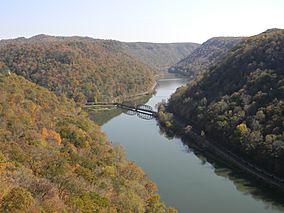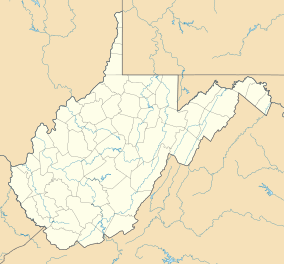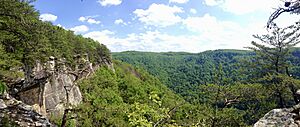New River Gorge National Park and Preserve facts for kids
Quick facts for kids New River Gorge National Park and Preserve |
|
|---|---|
|
IUCN Category V (Protected Landscape/Seascape)
|
|

The New River Valley from Hawk's Nest State Park.
|
|
| Location | Fayette, Raleigh, and Summers counties, West Virginia, United States |
| Nearest city | Beckley, West Virginia |
| Area | 72,808 acres (294.64 km2) |
| Established | 1978 |
| Visitors | 1,128,195 (in 2012) |
| Governing body | National Park Service |
| Website | New River Gorge National Park and Preserve |
The New River Gorge National Park and Preserve is a special place in the United States managed by the National Park Service. It protects the amazing New River Gorge in southern West Virginia, which is part of the Appalachian Mountains.
This protected area started in 1978 as a "national river." It stretches for about 53 miles (85 km) from near Hinton to Hawks Nest State Park. In 2020, during the COVID-19 pandemic, it officially became America's 63rd national park. This means it has the highest level of protection from the U.S. government.
The park is full of interesting history and beautiful nature. It offers many fun things to do, like whitewater rafting and rock climbing.
Contents
Exploring the New River Gorge
The New River Gorge is a fantastic place for outdoor adventures. It's known for some of the best whitewater rafting in the country. You can find exciting rapids, especially from Cunard to Fayette Station.
It's also a very popular spot for rock climbing on the East Coast. There are over 1,400 climbing routes here! The cliffs are made of very hard Nuttall sandstone. This rock has many features, like cracks and faces, perfect for climbing. Most climbs are about 30 to 120 feet (9 to 37 meters) tall. Many routes are for advanced climbers, but there are options for different skill levels.
How the Park Was Created
President Jimmy Carter signed a law on November 10, 1978, to create the New River Gorge National River. The goal was to protect the amazing natural beauty and history of the New River Gorge. It also aimed to keep a part of the New River flowing freely for everyone to enjoy now and in the future.
In 2020, the park's name changed to New River Gorge National Park and Preserve. A small part (less than 10%) became a national park, where hunting is not allowed. The rest became a national preserve, where most activities, including hunting, can continue as before.
Geology of the Gorge
The New River is like a sculptor, constantly shaping the land. It has created the longest and deepest river gorge in the Appalachian Mountains. As the river flows, it shows off many unique rock formations. You can see over 1,000 feet (300 meters) of sandstone and shale layers. There are also huge boulders, some as big as houses, scattered from the top of the gorge to the river.
The river has also revealed four layers of coal. This "New River coal" was once very important for powering trains, factories, and ships. It also helped make coke, which was used in iron furnaces. You can even find plant and animal fossils in the rocks!
Aquatic Life in the River
The New River system has many different water features, like pools, rapids, and waterfalls. These different areas create a special home for many water creatures. The river is very healthy and supports a unique aquatic ecosystem.
You can find many native fish species here, some of which live nowhere else! There are also mussels, crayfish, and many other water animals. Rare amphibians, reptiles, birds, and mammals also depend on the river. The area along the riverbanks, called the riparian zone, is especially rich in different kinds of plants and animals. It's a great place for smallmouth bass and other game fish.
Diverse Plants and Animals
New River Gorge National Park and Preserve is at the heart of a very important forest. It has more different kinds of plants than any other river gorge in central and southern Appalachia. It's also a crucial home for endangered mammals and rare birds and amphibians.
The park has many different habitats:
- Continuous forests: Large areas of trees.
- Cliffs and rimrock: Rocky edges of the gorge.
- Forest seeps and wetlands: Wet, marshy areas in the forest.
- Bottomland forests: Mature forests along the river.
- Abandoned mine portals: Old mine entrances that now provide shelter for rare animals like bats and the Allegheny woodrat.
The park is home to at least 63 types of mammals, including the endangered Virginia big-eared and Indiana bats. The river and its smaller streams provide homes for 48 known types of amphibians. These include the endangered eastern hellbender, black-bellied salamander, and cave salamander.
Bird Migration and Restoration
Many different birds, like wood warblers, vireos, and thrushes, spend part of their lives in warmer places. But they rely on the large, unbroken forests of the New River Gorge for breeding. This area is a vital stop on the north-south migratory flyway. Every fall, thousands of hawks fly through the region during their migration.
The National Park Service and West Virginia Department of Natural Resources are working together to bring peregrine falcons back to the New River Gorge. These amazing birds are known for soaring and diving near the cliffs.
Scientists have found 40 different plant communities in the gorge. These include at least 1,342 plant species, with 54 of them being rare.
Human History and Settlements
The gorge holds many historically important abandoned places. Some are just ruins, while others have been repaired. People lived and worked here in the late 18th and 19th centuries. They supplied coal and lumber that helped power American industries. The remains of these past times, hidden in the forest, tell stories of early life in the Appalachian Mountains.
You can see old coal mining structures and coke ovens, like those at Nuttallburg Coal Mining Complex and Town Historic District and Kay Moor. There are also ruins and structures from more than 50 company-owned towns.
The railroad arrived in 1873, connecting the New River Gorge region to the outside world. In the park, you can find old railroad depots, rail yards, bridges, and equipment. Towns like Thurmond grew up to support the railroad. The history of the lumber industry can be seen in the ruins of old towns like Hamlet. You can also find old farms, community sites, and homesteads where families connected to the New River lived and worked long ago.
Recreational Activities
The lower part of the New River is a top spot for whitewater rafting. The rapids are challenging, ranging from Class III to Class V. They have strong currents and large boulders, requiring skillful maneuvering. Companies offer rafting trips from April through October. The upper part of the river has easier Class I to III rapids, good for whitewater canoeing. You can find a list of licensed companies on the National Park Service website.
New River Gorge National Park and Preserve has become one of the most popular rock climbing areas in the country. There are over 1,400 climbing routes within the park. The cliffs are made of hard sandstone and are 30 to 120 feet (9 to 37 meters) tall.
Fishing is another very popular activity on the New River. The river has many different types of fish, making it an excellent place for warm water fishing.
There are over 50 miles (80 km) of hiking trails in the park. These trails range from easy walks to more difficult hikes. Some trails follow old railroad paths and are open for bikes. The park also has four simple camping areas located along the river.
You can visit two visitor centers year-round: one at Sandstone and another at Canyon Rim.
Major Features to See
- Babcock State Park (a nearby state park)
- Bank of Glen Jean
- Canyon Rim Visitor Center
- Fayette Station
- Grandview
- Hawks Nest State Park (a nearby state park)
- Kaymoor
- Nuttallburg Coal Mining Complex and Town Historic District
- Prince
- Prince Brothers General Store-Berry Store
- Sandstone Falls
- Sandstone Visitor Center
- Stone Cliff
- Thurmond, West Virginia
- Thurmond Depot
Images for kids








